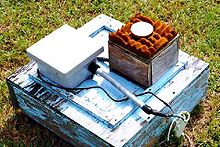Distrometer
A Distrometer (engl. Disdrometer ) is a made by the Swiss Jürg Joss and Waldvogel Albert electronic device for measuring the rainfall and type at a particular location.
In contrast to analog systems, which essentially consist of a measuring cup set up outdoors in which rainwater and the snow that melts into water are collected, a distrometer works as an automatic rain gauge ( ombrometer ), which also measures the type of precipitation and not just about whose amount provides information. Furthermore, distrometers measure the precipitation continuously over time.
Working principle
The exterior of the distrometer consists of an approx. 30 cm high metal cylinder, the upper surface of which is made of a measuring membrane on which the precipitation to be measured falls. Every single raindrop that hits it transmits a certain impulse to this membrane, which is essentially dependent on its mass and thus on its volume. This impulse is converted into an electrical signal.
The distrometer thus counts the raindrops falling on the membrane surface and simultaneously documents their size. The droplets are divided into so-called distrometer classes with regard to their volume. The amount of precipitation can easily be calculated from the information on how many drops of which class fell; Furthermore, the type of precipitation (drizzle, rain, shower, thunderstorm, etc.) is documented.
More modern disdrometers use a laser beam as a measuring principle , which is interrupted by falling raindrops; every interruption is counted and documented.
As measurement results, disdrometers usually provide graphs that show the disdrometer classes on the x-axis and the number of respective raindrops on the y-axis. Measurement curves typically result in the form of the gamma distribution .
Web links
- Joss-Waldvogel-Distrometer Institute for Atmosphere and Climate, ETH Zurich
- Self-made laser distrometer communications technology laboratory of the DHBW Ravensburg
Individual evidence
- ↑ Joss-Waldvogel-Distrometer Institute for Meteorology and Climate Research (IMK), Karlsruhe
- ↑ Distrometer: The measuring principle ( Memento from September 24, 2015 in the Internet Archive ) Institute for Atmosphere and Climate, ETH Zurich

